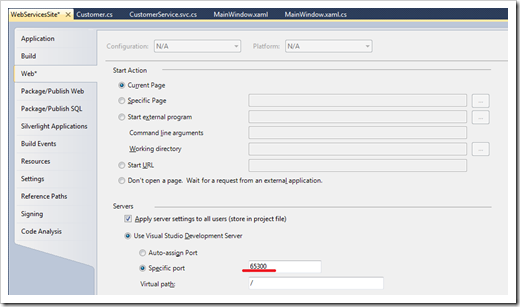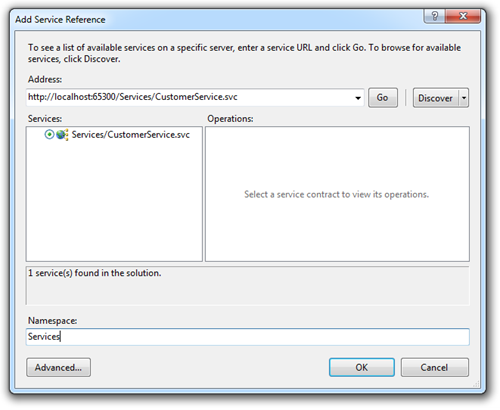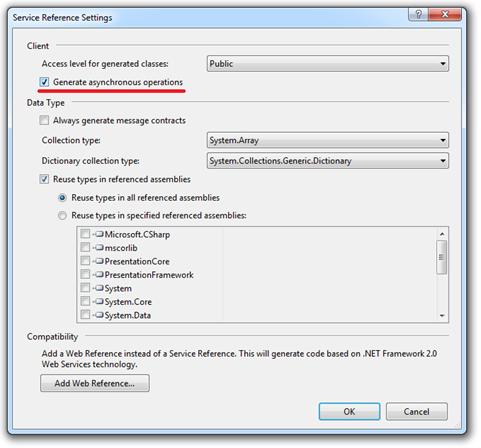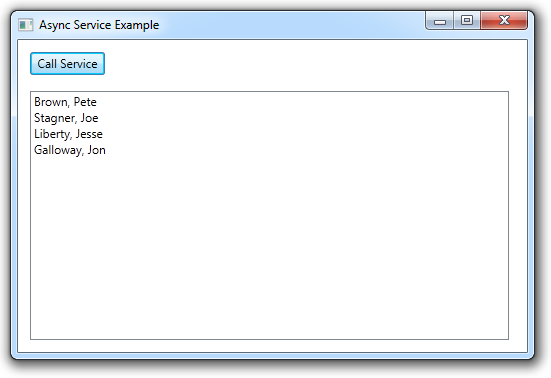An asynchronous network call is one in which you fire off a
method and don't block the thread while waiting for it to return.
This introduces some complexities since you have to somehow be
notified of the success or failure of the call, and need to somehow
retrieve the results.
Silverlight developers are used to making asynchronous network
calls because that's all the stack has supported since first
released. However, WPF developers can benefit from a little async
code in their applications to help make things a bit more
responsive.
Solution Setup
I created a solution into which I put a regular WPF Windows
application and an empty ASP.NET Web application.
Services Project
Into the ASP.NET Web Application, I added a "Silverlight-enabled
WCF Service". Why that template? It's a super simple approach to
creating WCF services that act like regular old SOAP services. It
keeps the example easy to follow.
The service is in a Services subfolder on the web project and is
named CustomerService.svc. Here's the code:
using System;
using System.Linq;
using System.Runtime.Serialization;
using System.ServiceModel;
using System.ServiceModel.Activation;
using System.Collections.Generic;
namespace WebServicesSite.Services
{
[ServiceContract(Namespace = "")]
[AspNetCompatibilityRequirements(RequirementsMode = AspNetCompatibilityRequirementsMode.Allowed)]
public class CustomerService
{
[OperationContract]
public IList<Customer> GetCustomers()
{
List<Customer> results = new List<Customer>();
results.Add(new Customer() { LastName = "Brown", FirstName = "Pete" });
results.Add(new Customer() { LastName = "Stagner", FirstName = "Joe" });
results.Add(new Customer() { LastName = "Liberty", FirstName = "Jesse" });
results.Add(new Customer() { LastName = "Galloway", FirstName = "Jon" });
return results;
}
}
}
In the same folder on the ASP.NET Service project, I added a
class named "Customer":
namespace WebServicesSite.Services
{
public class Customer
{
public string FirstName { get; set; }
public string LastName { get; set; }
}
}
Once you have the service set up, you'll want to fix the web
project's port just to ensure that you don't hang the service and
get stuck with a new port the next time you run. That results in
your app not finding the service and can be hard to debug unless
you know what you're looking for.

The actual port number isn't that important; I used the default.
Just be sure to set to Specific port to lock in that port number.
Silverlight developers: this isn't a bad idea when
working on your own web services in your
projects.
Next, add a service reference from your WPF project to the new
service in the ASP.NET project (be sure to build the solution
first). I named the namespace "Services"

Before clicking "OK", click the "Advanced…" button and select
the option to generate the asynchronous client operations. In
Silverlight, this is on by default as there's no other option. In
WPF, however, async operations are less typical.

If you received an error downloading the metadata, you
need to successfully build the web project first.
Next, we'll need to build some basic UI.
User Interface
I used the designer in Visual studio 2010 to create a dead
simple user interface. (In Xaml, I changed Name to x:Name as is my
habit), and added a simple item template to the ListBox. Here's the
markup:
<Window x:Class="WpfAsyncExample.MainWindow"
xmlns="http://schemas.microsoft.com/winfx/2006/xaml/presentation"
xmlns:x="http://schemas.microsoft.com/winfx/2006/xaml"
Title="Async Service Example"
Height="350"
Width="525">
<Grid>
<Button Content="Call Service"
x:Name="CallService"
Height="23"
HorizontalAlignment="Left"
Margin="12,12,0,0"
VerticalAlignment="Top"
Width="75"
Click="CallService_Click" />
<ListBox HorizontalAlignment="Left"
Margin="12,51,0,12"
x:Name="CustomerList"
Width="479">
<ListBox.ItemTemplate>
<DataTemplate>
<StackPanel Orientation="Horizontal">
<TextBlock Text="{Binding LastName}" />
<TextBlock Text=", " />
<TextBlock Text="{Binding FirstName}" />
</StackPanel>
</DataTemplate>
</ListBox.ItemTemplate>
</ListBox>
</Grid>
</Window>
The first approach we'll look at is the simple event-based
approach. So double-click that button and create an event handler
we can use in the remaining examples.
The Event Approach
When it's possible to use the event approach, this is by far the
easiest way to handle asynchronous calls, and is the approach used
most often in Silverlight code as well.
private void CallService_Click(object sender, RoutedEventArgs e)
{
var client = new Services.CustomerServiceClient();
client.GetCustomersCompleted += (s, ev) =>
{
CustomerList.ItemsSource = ev.Result;
};
client.GetCustomersAsync();
}
To keep the code even tighter, I used an anonymous delegate and
lambda expression to set up the event handler. You could also break
it apart into a separate method, but I personally find that muddies
the code.
The event approach is nice because you don't typically need to
worry about threading and marshaling a result back to the UI
thread; that's taken care of for you.
The next approach is a bit more flexible, but is also more
complex.
The Callback Approach
Another common approach is the callback approach. I often think
of this as the bare-bones method, as it is definitely a level or
two lower than the event approach. However, you gain some
additional flexibility in that there are no threading assumptions
made, and you can pass around your own state objects.
private void CallService_Click(object sender, RoutedEventArgs e)
{
// we'll need this to update the UI
SynchronizationContext context = SynchronizationContext.Current;
var client = new Services.CustomerServiceClient();
// this can be anything: a custom class or whatever you need
// to track state from the call to the response
CustomerRequestState requestState = new CustomerRequestState();
requestState.Client = client;
requestState.Context = context;
IAsyncResult asyncResult = client.BeginGetCustomers(
new AsyncCallback(ResponseCallback), requestState);
}
private void ResponseCallback(IAsyncResult asyncResult)
{
CustomerRequestState asyncState = asyncResult.AsyncState as CustomerRequestState;
Customer[] customers = asyncState.Client.EndGetCustomers(asyncResult);
// you can't just do this, as you'll get a cross-thread access error
//CustomerList.ItemsSource = customers;
// use SynchronizationContext and an anonymous delegate
// to update the listbox in the UI
asyncState.Context.Post((o) =>
{ CustomerList.ItemsSource = customers; }, null);
}
To make this work, we'll also need to create a state object to
hold the bits we want to pass from the call to the response
loading. I decided to track the calling WCF client (we'll need a
reference to that), the synchronization context, and an arbitrary
bit of data I don't actually use. Your own object can contain as
little or as much as you need.
namespace WpfAsyncExample
{
class CustomerRequestState
{
public string AnythingYouWant { get; set; }
public CustomerServiceClient Client { get; set; }
public SynchronizationContext Context { get; set; }
}
}
Now, I mentioned that I am passing around a
SynchronizationContext. That object allows us to make calls back on
the original calling thread, in this case, the UI thread. We need
to be able to marshal calls to that thread in order to update the
user interface. If you try and update the UI from a non-UI thread,
you'll get a cross-thread access exception.
Now, to keep things simple and understandable in the
above code, I haven't done any error handling or proper disposal of
objects. Make sure you do that in your production
code.
The final approach we'll look at builds upon what we've seen so
far, but makes it easier to do things like chain successive calls
without all the cruft you'd normally use.
Using Reactive Extensions
The final example uses an additional library knows as "Reactive
Extensions for .NET" or "Rx". This library does a ton of things to
help handle asynchronous operations without making your code into
an unintelligible bowl of calls and response callbacks.
First, get Reactive Extensions. You can either download
it from the main site, or better yet, use NuGet to add it
directly to your project. The NuGet approach will save you a ton of
time.
Learn how to use NuGet in your WPF projects here.
PM> install-package Rx-All
'Rx-Core (≥ 1.0.2856.0)' not installed. Attempting to retrieve dependency from source...
Done
'Rx-AsyncLinq (≥ 1.0.2856.0)' not installed. Attempting to retrieve dependency from source...
Done
'Rx-Interactive (≥ 1.0.2856.0)' not installed. Attempting to retrieve dependency from source...
Done
'Rx-Main (≥ 1.0.2856.0)' not installed. Attempting to retrieve dependency from source...
Done
'Rx-ClientProfile (≥ 1.0.2856.0)' not installed. Attempting to retrieve dependency from source...
Done
'Rx-ExtendedProfile (≥ 1.0.2856.0)' not installed. Attempting to retrieve dependency from source...
Done
'Rx-Testing (≥ 1.0.2856.0)' not installed. Attempting to retrieve dependency from source...
Done
You are downloading Rx-Core from Microsoft Corporation, the license agreement to which is available at http://go.microsoft.com/fwlink/?LinkID=186234. Check the package for additional dependencies, which may come with their own license agreement(s). Your use of the package and dependencies constitutes your acceptance of their license agreements. If you do not accept the license agreement(s), then delete the relevant components from your device.
Successfully installed 'Rx-Core 1.0.2856.0'
You are downloading Rx-AsyncLinq from Microsoft Corporation, the license agreement to which is available at http://go.microsoft.com/fwlink/?LinkID=186234. Check the package for additional dependencies, which may come with their own license agreement(s). Your use of the package and dependencies constitutes your acceptance of their license agreements. If you do not accept the license agreement(s), then delete the relevant components from your device.
Successfully installed 'Rx-AsyncLinq 1.0.2856.0'
You are downloading Rx-Interactive from Microsoft Corporation, the license agreement to which is available at http://go.microsoft.com/fwlink/?LinkID=186234. Check the package for additional dependencies, which may come with their own license agreement(s). Your use of the package and dependencies constitutes your acceptance of their license agreements. If you do not accept the license agreement(s), then delete the relevant components from your device.
Successfully installed 'Rx-Interactive 1.0.2856.0'
You are downloading Rx-Main from Microsoft Corporation, the license agreement to which is available at http://go.microsoft.com/fwlink/?LinkID=186234. Check the package for additional dependencies, which may come with their own license agreement(s). Your use of the package and dependencies constitutes your acceptance of their license agreements. If you do not accept the license agreement(s), then delete the relevant components from your device.
Successfully installed 'Rx-Main 1.0.2856.0'
You are downloading Rx-ClientProfile from Microsoft Corporation, the license agreement to which is available at http://go.microsoft.com/fwlink/?LinkID=186234. Check the package for additional dependencies, which may come with their own license agreement(s). Your use of the package and dependencies constitutes your acceptance of their license agreements. If you do not accept the license agreement(s), then delete the relevant components from your device.
Successfully installed 'Rx-ClientProfile 1.0.2856.0'
You are downloading Rx-ExtendedProfile from Microsoft Corporation, the license agreement to which is available at http://go.microsoft.com/fwlink/?LinkID=186234. Check the package for additional dependencies, which may come with their own license agreement(s). Your use of the package and dependencies constitutes your acceptance of their license agreements. If you do not accept the license agreement(s), then delete the relevant components from your device.
Successfully installed 'Rx-ExtendedProfile 1.0.2856.0'
You are downloading Rx-Testing from Microsoft Corporation, the license agreement to which is available at http://go.microsoft.com/fwlink/?LinkID=186234. Check the package for additional dependencies, which may come with their own license agreement(s). Your use of the package and dependencies constitutes your acceptance of their license agreements. If you do not accept the license agreement(s), then delete the relevant components from your device.
Successfully installed 'Rx-Testing 1.0.2856.0'
You are downloading Rx-All from Microsoft Corporation, the license agreement to which is available at http://go.microsoft.com/fwlink/?LinkID=186234. Check the package for additional dependencies, which may come with their own license agreement(s). Your use of the package and dependencies constitutes your acceptance of their license agreements. If you do not accept the license agreement(s), then delete the relevant components from your device.
Successfully installed 'Rx-All 1.0.2856.0'
Successfully added 'Rx-Core 1.0.2856.0' to WpfAsyncExample
Successfully added 'Rx-AsyncLinq 1.0.2856.0' to WpfAsyncExample
Successfully added 'Rx-Interactive 1.0.2856.0' to WpfAsyncExample
Successfully added 'Rx-Main 1.0.2856.0' to WpfAsyncExample
Successfully added 'Rx-ClientProfile 1.0.2856.0' to WpfAsyncExample
Successfully added 'Rx-ExtendedProfile 1.0.2856.0' to WpfAsyncExample
Successfully added 'Rx-Testing 1.0.2856.0' to WpfAsyncExample
Successfully added 'Rx-All 1.0.2856.0' to WpfAsyncExample
PM>
While that added a bit more than we'll use in this example, you
can control exactly what you get by only installing those packages.
Rx-All was the easiest thing for me to do for this example. There
are more than a few ways we can use Rx here, so I'm going to
concentrate on just one: using the event approach.
private void CallService_Click(object sender, RoutedEventArgs e)
{
// we'll need the UI thread just like last time
SynchronizationContext context = SynchronizationContext.Current;
var client = new Services.CustomerServiceClient();
// Wait for the GetCustomersCompleted event to finish. When
// it finishes, get the results from the event and
// using the thread context from "context", set the
// customer listbox item source to the result
var o = Observable.FromEvent<GetCustomersCompletedEventArgs>(
client, "GetCustomersCompleted")
.ObserveOn(context)
.Select(result => result.EventArgs.Result)
.Subscribe(s => CustomerList.ItemsSource = s);
// kick it off
client.GetCustomersAsync();
}
The code here initially looks as complex as the previous
versions, or at least as complex as the event version. However, one
subtle difference is that it has provided a nice way for us to
chain additional dependent calls. For example, so you need to first
call to get a customer ID, then make a separate call to get all the
invoices for that customer. That could involve some pretty ugly
call chaining in either the event approach or the callback
approach. The Rx approach will allow you to more easily chain those
calls together.

When you run the application, in all three approaches, you
should see the results shown here. Of course, what I have presented
is a simple example. In a real application, both the effort and the
benefits are greater.
Why is this even Necessary?
Like many of the practices we follow, it's not strictly
necessary. However, if you want to have a better user experience,
using either a spawned thread or an async call for service calls
can help keep your UI responsive.
Using async network calls also helps make your code and skills
more compatible with Silverlight. All the code here is
compatible with Silverlight.
Consider using async operations in your next desktop
application.
